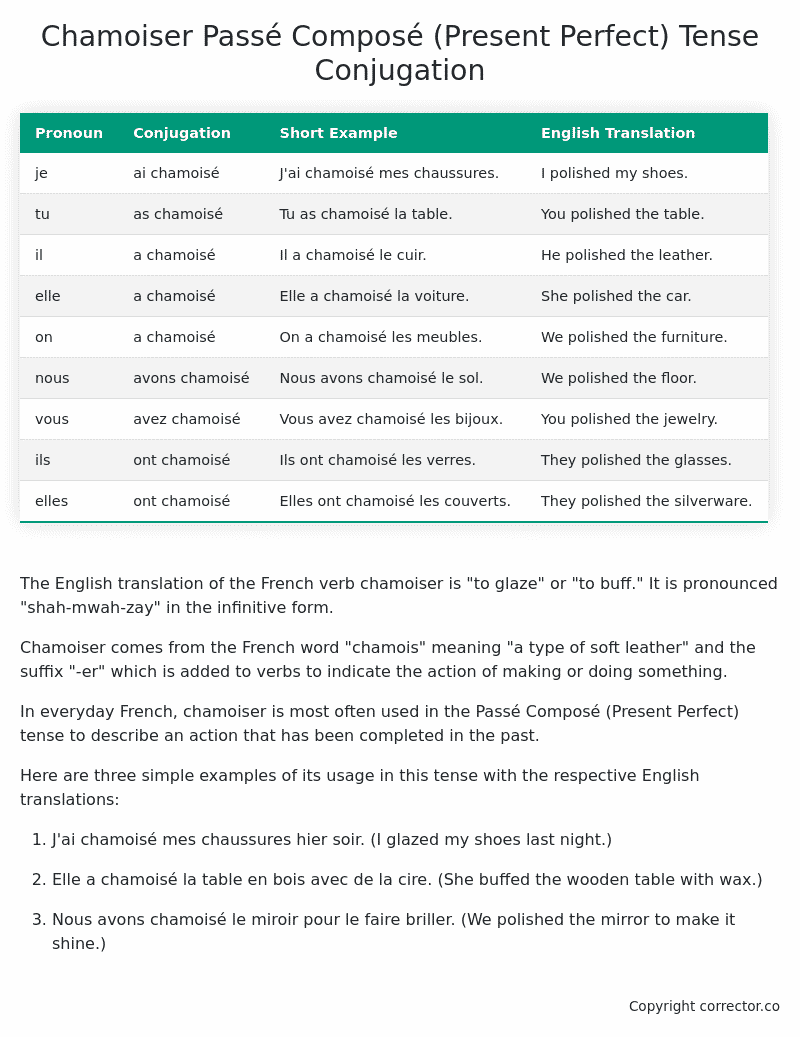Passé Composé (Present Perfect) Tense Conjugation of the French Verb chamoiser
Introduction to the verb chamoiser
The English translation of the French verb chamoiser is “to glaze” or “to buff.” It is pronounced “shah-mwah-zay” in the infinitive form.
Chamoiser comes from the French word “chamois” meaning “a type of soft leather” and the suffix “-er” which is added to verbs to indicate the action of making or doing something.
In everyday French, chamoiser is most often used in the Passé Composé (Present Perfect) tense to describe an action that has been completed in the past.
Here are three simple examples of its usage in this tense with the respective English translations:
-
J’ai chamoisé mes chaussures hier soir. (I glazed my shoes last night.)
-
Elle a chamoisé la table en bois avec de la cire. (She buffed the wooden table with wax.)
-
Nous avons chamoisé le miroir pour le faire briller. (We polished the mirror to make it shine.)
Table of the Passé Composé (Present Perfect) Tense Conjugation of chamoiser
| Pronoun | Conjugation | Short Example | English Translation |
|---|---|---|---|
| je | ai chamoisé | J’ai chamoisé mes chaussures. | I polished my shoes. |
| tu | as chamoisé | Tu as chamoisé la table. | You polished the table. |
| il | a chamoisé | Il a chamoisé le cuir. | He polished the leather. |
| elle | a chamoisé | Elle a chamoisé la voiture. | She polished the car. |
| on | a chamoisé | On a chamoisé les meubles. | We polished the furniture. |
| nous | avons chamoisé | Nous avons chamoisé le sol. | We polished the floor. |
| vous | avez chamoisé | Vous avez chamoisé les bijoux. | You polished the jewelry. |
| ils | ont chamoisé | Ils ont chamoisé les verres. | They polished the glasses. |
| elles | ont chamoisé | Elles ont chamoisé les couverts. | They polished the silverware. |
Other Conjugations for Chamoiser.
Le Present (Present Tense) Conjugation of the French Verb chamoiser
Imparfait (Imperfect) Tense Conjugation of the French Verb chamoiser
Passé Simple (Simple Past) Tense Conjugation of the French Verb chamoiser
Passé Composé (Present Perfect) Tense Conjugation of the French Verb chamoiser (this article)
Futur Simple (Simple Future) Tense Conjugation of the French Verb chamoiser
Futur Proche (Near Future) Tense Conjugation of the French Verb chamoiser
Plus-que-parfait (Pluperfect) Tense Conjugation of the French Verb chamoiser
Passé Antérieur (Past Anterior) Tense Conjugation of the French Verb chamoiser
Futur Antérieur (Future Anterior) Tense Conjugation of the French Verb chamoiser
Subjonctif Présent (Subjunctive Present) Tense Conjugation of the French Verb chamoiser
Subjonctif Passé (Subjunctive Past) Tense Conjugation of the French Verb chamoiser
Subjonctif Imparfait (Subjunctive Imperfect) Tense Conjugation of the French Verb chamoiser
Subjonctif Plus-que-parfait (Subjunctive Pluperfect) Tense Conjugation of the French Verb chamoiser
Conditionnel Présent (Conditional Present) Tense Conjugation of the French Verb chamoiser
Conditionnel Passé (Conditional Past) Tense Conjugation of the French Verb chamoiser
L’impératif Présent (Imperative Present) Tense Conjugation of the French Verb chamoiser
L’infinitif Présent (Infinitive Present) Tense Conjugation of the French Verb chamoiser
Struggling with French verbs or the language in general? Why not use our free French Grammar Checker – no registration required!
Get a FREE Download Study Sheet of this Conjugation 🔥
Simply right click the image below, click “save image” and get your free reference for the chamoiser present perfect tense conjugation!

Chamoiser – About the French Passé Composé (Present Perfect) Tense
Formation of the Passé Composé
Set the auxiliary verb with either
Conjugate the auxiliary verb
Add the past participle
Common everyday usage patterns
Narrating Past Events
Sequential Actions
Describing Completed Actions
Interactions with other tenses
Imperfect Tense
Conditional and Future Tenses
Summary
I hope you enjoyed this article on the verb chamoiser. Still in a learning mood? Check out another TOTALLY random French verb conjugation!


